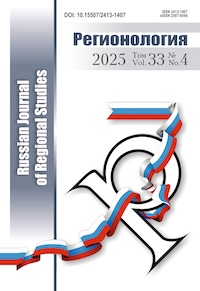A. O. SINITSYN, A. V. TSYGANTSOV. GAMES WITH ALLOCATION OF ECONOMIC RESOURCES BETWEEN MEMBERS OF A CLUSTER
A. O. SINITSYN, A. V. TSYGANTSOV.
GAMES WITH ALLOCATION OF ECONOMIC RESOURCES BETWEEN MEMBERS OF A CLUSTER
Key words: economic cluster, coalition games, cooperation of economic agents, economic resources
Abstract. The paper discusses the approaches to settle the issue of distribution of economic resources between the clusters' members. A model of optimization of the system of cooperative relations between the economic clusters' members is proposed both for the case of presence of an administration agent, and for the case of its absence, when the economic clusters' members cooperate on the basis of the principle of competitiveness.
Synopsis. Introduction: currently, the cluster approach to the setup of economic space once again becomes an object of interest for researchers as a tool for regional economic development. Despite the fact that this issue has been actively explored since at least the mid-1980s, the theoretical material is continuously updated; yet it has to be comprehended and approaches to work with it are to be developed. This is due to the fact that the subject area lies in the dynamic socio-economic space: the cluster projects are implemented all over the world in different forms, they are included in a number of European, American and Asian territorial economic development programs. Moreover, the methodology of working with economic systems is being developed.
Materials and Methods: the paper applies the methodological apparatus of game theory — the principle of the antagonistic type of the behavioral model of communities for the case of possible cooperation. The concept of the Nash equilibrium is applied for the participants of the economic cluster. Methods of V. Leontiev's economic and mathematical balance model are also applied. Elements of the approach of a thermodynamic analogy in Economics are used as well as the game theory methods for the case of coalition games, and methods of modeling resource flows in the context of the thermodynamic analogy approach.
Results: the applied methodological approaches of game theory allowed to obtain a simplified model of functioning of the economic cluster in terms of resource allocation between its members.
Discussion and Conclusions: a system of gaming simulation of maximizing the efficiency of allocation of economic resources between members of the clusters was developed. From this perspective, scenarios of formation of cluster structures for the model of self-organizing process where economic cluster members cooperate on the basis of the principle of increasing competitiveness were considered, as well as the scenario of optimizing the allocation of investment by an outer operator. The methods of game theory for the case of coalition games were used as well as the methods of modeling resource flows in the context of the thermodynamic analogy approach. Cooperative models of behavior of members of cluster structures were reviewed and methods to optimize the resource allocation system were proposed.
REFERENCES
1 Rabota vypolnena pri podderzhke granta RGNF 16-02-00674, prezident-skogo granta MK-5140.2015.6 [The paper was completed with the support of the grant from the Russian Foundation for the Humanities 16-02-00674,
Presidential grant MK-5140.2015.6].
2 Pecherskiy SL, Belyaeva AA. Teorija igr dlja jekonomistov. Vvodnyj kurs [Theory of Games for Economists. Introductory Course]. St. Petersburg: EUSP Press Publ.; 2001. 342 p. Available from: http://elibrary.ru/item.
asp?id=22641930 (accessed 11.02.2016). (In Russ.)
3 Ibid.
4 Nash JF. Non-Cooperative Games. The Annals of Mathematics. Second
Series. Vol. 54. Iss. 2 (Sep., 1951). P. 286—295.
5 Bulyarskiy SV, Bulyarskaya SA, Sinitsyn AO. Modeli upravlenija promyshlennymi klasterami [Models of Administration of Industrial Clusters].
Ulyanovsk: Kolor-Print Publ.; 2013. 152 p.
6 Bulyarskiy SV, Sinitsyn AO. Optimizacija raspredelenija investicij v promyshlennyh klasterah [The optimization of the distribution of investments in the industrial clusters]. Vestnik Orenburgskogo gosudarstvennogo universiteta = Bulletin of the Orenburg State University. 2011; 8:30—32. Available from:
http://elibrary.ru/item.asp?id=17855733 (accessed 13.04.2016). (In Russ.)
7 Leontiev V. Input-Output Economics. 2nd ed. New York: Oxford University
Press; 1986. 448 p.
8 See reference number 6 in the list of References.
SINITSYN Anton Olegovich, Candidate of Economic Sciences, Senior Research Officer at the Department for Scientific Research, Ulyanovsk State University (Ulyanovsk, Russian Federation), e-mail: antonsinitsyn@mail.ru.
TSYGANTSOV Andrei Valerievich, Candidate of Physical and Mathematical
Sciences, Senior Research Officer at the Department of Engineering Physics, Ulyanovsk State University (Ulyanovsk, Russian Federation), e-mail: ats2412@ya.ru.

All the materials of the "REGIONOLOGY" journal are available under Creative Commons «Attribution» 4.0
















